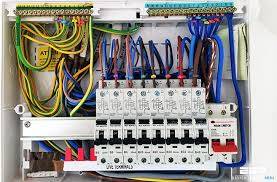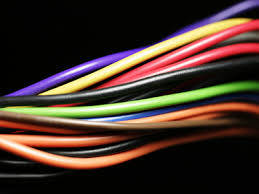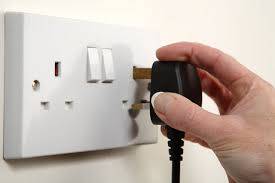An electrical circuit is one of the most important, and widely used, components within anything that resembles technology. If you look around yourself, you will find that your TV has an electrical circuit, so does your laptop, microwave, toaster, mobile; basically, almost everything around you will have incorporated some sort of electrical circuit in order to function.
This also fundamentally includes the fixed wiring in your property which is supplying electricity to the outlets (sockets), which in turn supplies power to your appliances. As such, there will definitely be times when you will notice that things don’t seem to work properly; your electrical circuit might be faulty or displaying abnormalities which are usually highlighted by a tripping fuse. When you notice such irregularities, call a local approved electrician who can help you fix any faulty electrical circuit. Perhaps explore opting for Grovebell Electrical; we will provide you with qualified electricians who you can count on to get the job done.

You may wonder, however, how does one exactly fix a faulty circuit? There are a few different ways through which you can fix problems like short circuiting, overheating and excessive flow of voltage –all depending on the type of circuit, its quality and the intended function of the circuit. Normally, a local approved electrician would go through the following series of action to effectively solve the problem:
Analyze
- All faulty circuits manifest characteristics that immediately draw attention to them because they may cause appliances to malfunction or to cease working altogether. Just by analyzing and paying careful attention to the appliance, your electrician may be able to correctly identify what the problem is.
- The very first thing is to look for any damages that can be seen by the eye –including broken- or worn-down wires (if on the surface). Structural damage to power outlets due to impact, discoloration or in some serious cases sparking. Even unusual sounds coming from a socket or fused outlet can give a sense of what the problem may be.
- Overheating is also one of the major problems that can cause serious damage to the circuits. More often than not, overheating can cause parts, like the insulation, of the circuit to break down and melt away. An electrician will have to rule out overheating, if the problem lies somewhere else, by checking temperatures and looking for signs like deformed parts to correctly troubleshoot the circuit.
- A local approved electrician will also be aware of the fact that once you report in a problem, the fault may not lie in only one part of the entire circuit. They will be able to separate the perfectly functioning parts with those that seem to be causing trouble through the process of elimination.

This close inspection of electrical equipment or objects is what will allow an electrician to identify and label the fault that has presented itself. In most cases, it is easy to define the problem since all the faults manifest in some sort of malfunctioning that can be seen, heard, smelt or felt even.
Figure out the cause
Once the faults have been identified, and labeled, the next logical step is to ask, ‘what caused this to happen?’
- In a circuit, there is an array of situations that could cause a part to malfunction, or completely halt its functioning. As the electrician notes down the observations, they immediately start thinking about the possible causes for them. The reason being that they have been qualified and trained in a way that they are fully aware of the way the circuit is supposed to function. Thus, when a fault presents itself, they are able to logically figure out potential causes and then, through their observations make eliminations.
Components that have burned out, like switches, fuses, coils, and motors, will often be due to fluctuation or excessive intake of voltage. If they find that the problem is with the connection then it is likely that there is a problem with the wiring. They could potentially have been worn out or damaged which leads to a disruption in the flow of current thus causing your equipment to become faulty.
Provide a solution
- Once you have identified the problem and its cause, the final step is providing a solution and employing it. In some situations, it may be hard to exactly figure out the problem so the use of test instruments, like the multimeter, is suggested which allows for the process of troubleshooting to become a lot easier.
- They can measure things like continuity, amount of voltage and the level of resistance the conductor is enduring from point A to B. Additionally, such instruments can be used to figure out the basic function of each and every part of the circuit. It highlights any abnormalities and makes it easy to fix.
- Sometimes, all it might take is the replacement of the damaged cable with a brand new, well-functioning, one. Otherwise, you might have to make minor tweaks and alterations, like fixing or rerouting wires or even resetting a fuse, which would restore the functionality of the object. For instance, an open circuit may cease to function if the connection is broken at some point or another. All it will take is a simple continuity test to find out where the problem lies and a rewire to fix it. Similarly, a short circuit is the damaging of components due to excessive flow of current. This is usually fixed by installing improved and highly resistant insulation to prevent such a scenario from happening again.
Rechecking

Once a circuit has been repaired and switched on, a local approved electrician will do a simple recheck. Any devices, appliances or equipment will be powered to check if it’s functioning the way it is intended to. If it works perfectly, then everyone will now that the job has been done right and that the problem is fixed. However, if there are still some faults, additional checks will need to be carried out to assess the situation. More often than not, a circuit may have more than one fault which requires a more meticulous approach.
EMERGENCY ELECTRICIANS in London
You never know when your circuit will start to malfunction and you need an emergency electrician to aid in the diagnosis and repair. It doesn’t matter what time of the day it is, or what day it is in fact, you can count on Grovebell Electrical’s 24-hour emergency electricians to provide you with the services of excellent, qualified, and trained electricians. All you have to do is give us a call on 0207 209 8137 or email us at enquiries@grovebellelectrical.com
